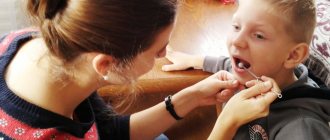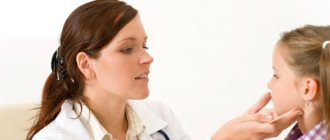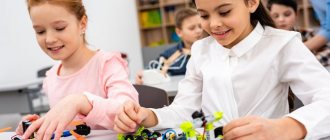What is massage for speech development?
How will it help improve a child's speech?
What types of speech massage can you do at home yourself, and which ones should you entrust to a specialist?
We will answer these and other questions in this article.
- Passive massage techniques
- Forehead massage
Who provides speech therapy massage for mental disorders?
All procedures differ in methods of implementation and areas of influence. As for speech therapy massage, its main task is to develop articulatory muscles and improve the condition of nerves. In this way, massage is performed exclusively in the area of the oral cavity and tongue. It is often prescribed to children aged 4-5 years when diagnosed with RRD. Usually combined with other types of massage and articulation exercises.
Who performs speech therapy massage for mental retardation:
- In order to perform speech massage, you must use a probe or fingers. Usually carried out by a speech therapist or parents. Please note that nails must be trimmed and there must be no jewelry on the hands.
- Most often this manipulation is carried out with gloves. It is worth noting that any massage for ZRR is prescribed exclusively by a neurologist. After examining the child, the doctor may write a referral to a speech therapist.
At the doctor
Contraindications.
But we must not forget about contraindications that you should familiarize yourself with before a speech therapy massage session for you or your child. This procedure is undesirable:
- any somatic disease or infectious disease in the acute period;
- acute and chronic skin diseases;
- gingivitis, stomatitis, the presence of herpes on the lips or other infections of the oral cavity;
- the presence of enlarged lymph glands;
- increased intracranial pressure.
- epilepsy.
How is palm massage performed to develop baby's speech?
Palm massage is quite effective in dealing with RRR. Usually it is carried out independently by parents or children. It can be divided into active and passive. Passive is performed by parents or a doctor; as a result of the massage, areas on the palms and fingers of children are worked out. Both the outer and inner parts of the palm, as well as the area up to the elbow, are massaged. Just 15 minutes is enough to stretch these areas. In order for the child to calmly perceive the massage, it is carried out in a playful way, supplemented with poems and nursery rhymes.
While the child is small, parents perform this massage on their own. As soon as the baby masters the technique of performing such a massage, he can do it on his own.
Palm massage for baby speech development:
- It is necessary to stroke the child’s hands from the outside and inside. To do this, the touch should be very light, and sort of ticklish. Parents tickle the child's palm.
- White-sided magpie. This is a well-known nursery rhyme, during which a finger makes spiral movements in the area of the inner side of the palm.
- Blizzard. It is necessary to stroke your hands in a zigzag manner. At the same time, recite a poem about a blizzard.
- Snail. During this exercise, the palms are not just stroked, but thoroughly massaged and pinched.
Active points
Alternatives to logomassage
Speech therapist services are not that expensive. But parents whose child does not show positive results begin to look for alternatives to the procedure.
One option is neurofeedback or bioacoustic correction.
During the procedure, sensors are attached to a person's scalp to record brain wave activity. The doctor will be able to record the graph of brain activity during communication. The child is then fitted with headphones through which the “voiced” brain signals can be heard. This treatment is prescribed to children with severe speech delays.
Music therapy is more suitable for young patients without mental retardation. The baby is encouraged to listen to rhythmic songs and sing along to them.
How is facial massage performed for ZRR?
When performing the procedure, the doctor acts on the child’s forehead, cheeks, and chin. Typically, stroking, vibration, rubbing and even tapping are performed in this area.
How is facial massage performed for ZRR:
- In order to perform a forehead massage, it is necessary to carry it out along the massage lines. To do this, you need to move your fingertips, with a very light touch, with both palms from the middle of the forehead to the temporal part. The exercise is performed with both hands at once. Next, you need to massage your forehead from the eyebrows to the top of the forehead. The result is a zigzag movement.
- When performing a cheek massage, you need to rub along the lines, from the corners of the lips to the temples. As in the first case, it is necessary to carry out movements with both hands at once. Next, you need to perform stroking movements from the temple, touching the cheekbone area, and towards the lower jaw, going down to the collarbone area.
- Rub the upper lip from the middle to the corners of the mouth. Movements should be circular or zigzag. Carry out exactly the same exercises with the lower lip.
- The chin is often massaged using circular movements in a spiral direction from the chin to the corners of the mouth.
Satisfied child
How is massage of the collar area performed for cervical cancer?
For RRR, massage of the neck, shoulder blades, and collarbones is quite effective. He prescribes not only for stimulation, but also for general improvement of the body’s condition. The fact is that a common cause of RRD is birth trauma, as well as pinched nerves in the neck. This allows you to improve blood circulation in the brain area, thereby stimulating the development of the speech apparatus. During the massage, all muscles, as well as the brain, are saturated with oxygen. This occurs due to stimulation of the area responsible for speech.
How is massage of the collar area performed for cervical cancer:
- Usually the massage session is not very long, only 20 minutes. Please note that it is performed without pain or strong pressure. Consists of approximately 20 sessions. Recommends repeating after 2 months. When performing a massage, the child is laid on his stomach, with his arms along the body. The massage begins with light stroking, movements from top to bottom, in the neck area.
- After this, you can increase the pressure and perform rubbing movements in this area, but with three phalanges of your fingers. After this, a massage is performed on the muscle that is located between the neck and shoulders. It is necessary to work not only the neck, but also the upper back.
- It is worth noting that speech therapy and speech massage is quite useful, but in order for it to give a good result, it should be combined with breathing and voice exercises.
Article:
Speech is a means of human intellectual development, his successful adaptation and socialization, therefore the most important aspect of the mental development of children is their speech activity [6, p.
78]. Today, one of the main problems in the field of speech therapy and defectology is speech development delay (SDD). According to statistics, every fifth child suffers from delayed speech development. A child’s speech delay is very alarming for parents, and if measures are not taken to eliminate it in time, it can develop into a huge problem.
ZRR represents a later acquisition of oral speech skills by children under three years of age compared to the corresponding age norm. This condition is characterized by a qualitative and quantitative disorder in the development of vocabulary, unformed expressive speech, and the child’s lack of phrases by the age of two and coherent speech by the age of three [4, p. 42].
According to many domestic psychologists and teachers, speech is an integral link in the process of socialization of a child in modern society. In addition, based on literary sources, we can confidently say that speech activity is a skillful, subtle psychological process, the formation of which occurs in the first years of a child’s life. Accordingly, the process of speech acquisition during ontogenesis has specific and individual characteristics and depends on many factors, which include:
a) gender of the child (in boys this disease occurs 4 times more often than in girls;
b) social environment;
c) intra-family relationships;
d) physical and mental development;
e) functioning of the nervous system, etc.
Now we will consider in detail the possible reasons leading to RRR. They can be divided into two large groups: biological reasons and social reasons. A solid foundation, which is more difficult to correct, is fraught with biological reasons. They have an organic basis. Experts include prenatal damage to the child’s brain here: minimal brain dysfunction, fetal hypoxia, infectious diseases. In addition, the most common disorders in the anamnesis of such children are: asphyxia, birth injuries, prematurity or postmaturity, traumatic brain injuries, malnutrition, and frequent illnesses. It is also necessary to take into account the functioning of the child’s auditory analyzer: if a child has hearing impairment, then the development of speech function will be delayed, and it will undergo a number of changes. An important factor is the genetic predisposition to speech disorders: if a parent started speaking at a fairly late age, then there is a high probability that this disease was passed on to the child [3, p. 100].
Social causes have a different foundation and are more easily amenable to corrective intervention. Social and pedagogical prerequisites lie in the unfavorable environment within the family, which, as a rule, leads to a deficit in verbal communication. Reasons of a social nature include pedagogical neglect, hypo- or hyper-custody, “hospitalism syndrome” due to frequent illnesses of the child, moving, or being in a dysfunctional family; the presence of bilingualism in the family, unfavorable speech environment and stress [5].
One cannot ignore the fact that both a lack of verbal communication and an overly informed environment have a huge impact on the development of speech at an early age. Here the child, as a rule, is faced with an excess of information that is not interesting to him and does not correspond to his age. The result of this situation is the child’s refusal to listen to the speech, to delve into what is said; the baby refuses to comprehend and realize the meaning of words and phrases. Subsequently, the child begins to use template phrases in speech that are not related to the situation at hand.
It should also be noted that the process of speech development directly depends on the development of the child’s fine motor skills. It is for this reason that from the very birth of a child, people around him must take measures that will allow him to develop this necessary skill and ensure the further development of speech function and, as a consequence, his successful study and socialization. Such measures include massaging the baby’s fingers and palms, purchasing toys and rattles with a rough and uneven surface and parts; later toys with lacing, Su-Jok balls, rings, etc.
Delayed speech development may not initially be asymptomatic. At various stages of speech development, such children exhibit characteristic signs that indicate impaired development. For example, during the pre-speech period, a child may experience low activity of humming, babbling, silent speech, and vocalizations of the same type. The most striking reason is the lack of speech sounds and toys in a child aged 1 year. This reason should seriously alert parents. Later, SRD may manifest itself in inactive attempts to repeat the words of surrounding people by a child aged 1.5 years, the inability to follow simple verbal instructions perceived by ear, the absence of independent words in the active dictionary; use of non-verbal means of communication. As a result, by the age of three, a child may experience a complete lack of independent, situational speech. His speech capabilities will be limited only by the use of memorized words and phrases in speech [2, p. 151].
Elimination of speech development delay is a very labor-intensive, complex, lengthy process that requires the attention of specialists in pedagogical, psychological, defectological and medical fields. The child is prescribed a full medical examination by the pediatrician, which includes the following procedures: ECG, EEG, MRI. Next, the examination is carried out by an otolaryngologist and a neurologist. A child psychiatrist, psychologist, speech therapist and defectologist will carry out correctional work with the child almost daily.
Parents need to understand that solely speech therapy assistance in eliminating developmental disorders in a child will not be enough. It is necessary to take medications and perform various physiotherapeutic procedures. But therapy with the use of drugs will bring little results if parents refuse auxiliary pedagogical influence from a defectologist and psychologist. Close relatives also need to master speech therapy massage and special exercises that will help them cope with their child’s illness much faster and more efficiently.
Of course, each specialist in the process of examination, treatment and correctional work uses his own means and techniques, which have an exclusively positive effect on the mental, physical and speech state of the child. First of all, the specialist discusses with the parents the need to create a favorable and comfortable speech environment, in which it is necessary to demonstrate correct speech, which should serve as a “push” in stimulating the child’s speech activity. Next, the child’s speech is corrected in speech therapy sessions.
A speech therapist in his work with children with developmental disabilities can use various techniques: gaming technologies, work with poems, mnemonics, sand therapy, modeling, the method of project activities, massage. Massage techniques in this case are divided into two categories: speech therapy massage (massage of the face, tongue, cheeks) and massage of the collar area. I would like to dwell in more detail on working with the collar area.
It is difficult to overestimate the importance and necessity of such a corrective remedy for cervical-collar zone massage. Many medical specialists have studied the dependence of speech and the condition of the child’s cervical spine: congestion was very common due to constant tension in the collar area (incorrect position of the body during sleep, birth injuries, prolonged sitting, etc.). Unfortunately, today little attention is given to this means of correcting speech pathologies. It is for this reason that below we will reveal the need to introduce this technique into speech therapy.
According to medical sources, massage techniques for the cervical-collar region can lead to normal functioning not only of the child’s speech skills, but also the functioning of his nervous system as a whole. The most vulnerable spot in the body segment we are considering is the first vertebra of the Atlas, which is localized at the very base of the neck. The statistics on the violation of the structure of this vertebra are shocking - in more than 90% of people it is displaced. The reason for this is incorrect birth, since during childbirth the baby is subjected to very strong mechanical stress. The situation is aggravated if childbirth takes place unnaturally, but with the help of obstetric devices. The result of this situation is the displacement of this vital segment of the spine.
It must be taken into account that even minimal damage to the cervical vertebra Atlas most often leads to its displacement. The result of this damage is a disruption, a decrease in cerebral blood flow due to narrowing or compression of the arteries of the spinal canals. Since blood circulation throughout the body is disrupted, its vital functions begin to noticeably suffer. This manifests itself in problems with the musculoskeletal system, decreased mental abilities and awareness, diseases of organs and systems, migraines, dizziness, epilepsy, dysfunction of speech zones (possible refusal to speak, misunderstanding of what is said), mental retardation and mental retardation; in severe cases, this manifests itself in mental retardation, impaired growth and physical development. When Atlas is displaced, initially there are already prerequisites in the body that lead to the occurrence of radiculitis, osteochondrosis of the cervical spine, compression of nerve processes and diseases associated with deformation of the human spine. Naturally, in this situation the child will not develop fully. In addition to the above, an incorrectly positioned cervical vertebra puts significant pressure on the spinal cord. The body's signals reach the nervous system with a delay, which reduces the brain's ability to process information and affects the timing and correctness and adequacy of the reaction.
Since the displaced Atlas compresses the blood arteries supplying the brain, the child noticeably begins to lag behind in development, his interest in speech, attention, mental clarity, awareness and memory decrease. The child does not want to understand the speech of the people around him and cannot follow basic instructions; he does not develop or noticeably lags behind the sounds of early ontogenesis and other components of speech that develop later: vocabulary, grammar, phrasal and connected speech.
Based on the above, it can be argued that a speech therapist, when working with a child with mental retardation, should use not only methods that develop speech skills, but also massage techniques for the cervical-collar region, which is necessary to restore the normal physiological base of the child’s body. Massage of the collar zone in children helps to increase blood flow to the brain (in particular, the speech zone is better supplied with blood), nutrients and oxygen. Next, we will take a closer look at the massage technique for ZRR.
In order to use cervical massage techniques in speech therapy practice, a specialist needs to undergo medical courses, gain basic, basic medical knowledge of the anatomy and physiology of the child’s body, so as not to harm the child even more. In the method of using massage, the first and most important step is to win over the child. The procedure should be carried out in a relaxed atmosphere, even if the speech therapist works in a medical office. The room should be equipped with toys, a couch, a stool or a small chair for the massage procedure. In no case should there be objects in the room that could frighten the child or cause a negative reaction in him - syringes, enemas, thermometers - all this must be removed from sight. During the massage, you can play relaxing classical music or funny children's songs in the background. Before the procedure, you need to ask the child how he is feeling, how his day went, whether he has any pain, etc. The main goal is maximum relaxation of the child [1, p. 52].
If a child attends speech therapy classes with a specialist (speech therapist, speech pathologist-speech pathologist), who gives him a massage, then the lesson can be structured as follows: speech warm-up, familiarization with the topic of the lesson, encouraging the child to speak using various techniques and game exercises, and, as soon as If the child feels tired, it is necessary to stop the activity and give him a massage according to the requirements set out below. While performing the massage technique, it is necessary to communicate with the child and repeat the material covered.
During the massage, movements are performed from top to bottom, while avoiding the area of the spinal column. The massage begins with light stroking, the pressure gradually increases, the movements turn into “rubbing” and “squeezing”. After “squeezing” they move on to rubbing. It is performed with three fingers: index, middle and thumb; They usually knead the trapezius muscle. The massage ends with rubbing and kneading on the upper back and shoulder joints. The duration of one massage session is at the initial stages 15 minutes, later – up to 25 minutes. It should be noted that if there is a stool in the massage room or room, you must purchase a high table. In this case, the massage will be performed as follows: a stool must be placed in front of a high table. A soft, comfortable pillow (preferably bright, for children) is placed on the table, on which the child’s head rests [1, p.43].
Since the massage is performed by a speech therapist, the specialist must under no circumstances remain silent during the process: any movement is accompanied by speech in a calm, gentle tone (thus we provoke the child with mental retardation to speak). It is necessary to take into account the fact that when performing massage techniques, the child may experience pain. In this case, it is necessary to reduce the pressure and try to relax the tense muscle as much as possible.
In general, children's massage has a number of specific features and requires increased attention from a specialist and special equipment in the office. In addition, for each age group of children in medicine, there are certain requirements for a specialist: for example, children under one year of age can receive massage only after they have reached seven weeks. For such patients, only stroking the collar area is allowed. After the child reaches 6 months, the use of rubbing the cervical-collar area is allowed. The trapezius muscles must be massaged from top to bottom and under no circumstances should pressure be placed on the spine, since the child’s bones and muscles have not yet become stronger and instead of benefit, irreversible damage can be caused.
It should be noted that if the massage technique is performed correctly, after the first visit to the massage room you can be convinced of the positive effect of massage of the cervical-collar area. If the child was hyperactive and restless, then after the procedure the child becomes more willing to study, can listen longer, carry out tasks and verbal instructions. The child’s well-being noticeably improves, headaches and dizziness disappear. In some cases, after attending five procedures, the child began to demonstrate speech functions, a desire to communicate with others, and explain his desires using words and phrases. With further implementation of such therapy, the child’s likelihood of developing secondary disorders in the structure of speech defects, scoliosis and problems with posture is reduced.
Thus, we can conclude that massage of the cervical-collar area is very useful for children with delayed speech development. The collar zone, which includes the neck, shoulder girdle, and back of the head area, is one of the reflexogenic zones of the human body, rich in blood arteries that supply the brain with blood, essential microelements and oxygen. If your child is diagnosed with RRD, you should consult a doctor who will prescribe this procedure. After just a few massage sessions, the blood supply to the brain of a child with mental retardation significantly improves, and speech therapy sessions in combination with massage techniques for the cervical-collar region produce excellent results. Soon the child’s speech abilities will correspond to the norm of development in his age category [7, p. 41].
What kind of massage can be used for cerebral palsy in children 3 years old?
For children aged 3 years, massage of the collar area is usually used, less often articulation gymnastics. At this age, the most important thing is to develop fine motor skills of the hands, influencing the centers located on the palms and hands.
What kind of massage can be used for cerebral palsy in children 3 years old:
- Therefore, the best option is to purchase prickly balls, small clothespins, and cereals. Let your child sort through the cereal and play with it more often. It is necessary that the active points on the child’s fingers are constantly activated. This stimulates brain development, thereby improving the child's speech.
- Remember, neck massage is most effective at the age of 3 years. It improves blood circulation in the brain, thereby improving the overall well-being of the child.
- It is best to perform a massage only after consultation with a doctor and demonstration of the exercises by an experienced massage therapist. The fact is that if you press hard enough, you can harm the child.
Massage with a probe
How is speech therapy tongue massage performed at home?
Speech therapy massage of the tongue is very effective in the fight against mental retardation. It can be carried out either with a special probe or with a toothbrush. This is done using gloves, lint-free wipes, and a clean toothbrush with silicone bristles.
How to perform speech therapy tongue massage at home:
- Initially, the tongue is stroked lengthwise, then from the center to the right and left. It is performed with short breaks, as the tip of the tongue is held all the time, which leads to constant drooling and discomfort in the child.
- Gentle stroking should be done without strong pressure, as the bristles of the brush can be quite hard and unpleasant. Under no circumstances should you cause pain to a child.
- During the massage, patting and tapping movements are often performed. For these purposes, it is best to use a toothbrush with silicone bristles, rather than a standard one made of nylon.
- This helps make the massage palpable and influence the points that are on the tongue. This allows you to stimulate the muscles of the tongue, improve its functioning, which helps in reproducing some hissing sounds that are difficult for a child.
Tongue massaging scheme
How to know when it's time to seek help
You should not hire a speech therapist for a one-year-old child who is not yet physically formed to pronounce sounds correctly. But you shouldn’t delay asking for help. By first grade, your child should already be able to communicate freely.
If you have doubts about the advisability of logomassage, you should focus on the following criteria.
You need to seek help if your child is over 5 years old, but his speech is unclear and it is difficult for others to understand the essence of the appeal.
When reading or trying to retell long stories, the baby stutters, repeats the same words, and lengthens sounds.
We should be wary of trends towards simplifying phrases. For example, instead of saying: “Mom, I want to wear green pants, not red,” the child begins to become hysterical, shouting: “Mom, I don’t want to.” The help of a speech therapist is definitely needed if speech problems prevent the child from establishing first social connections with peers.
The child may have the ability to read aloud and demonstrate excellent pronunciation in the family circle. But if the child withdraws in public, then it is worth “rehearsing” the process of communication with a specialist.
A clear indication for seeking professional help will be diagnosed diseases, including:
- Down syndrome;
- autism;
- hearing loss.
In such cases, you should not wait for a certain age. Tongue massage is necessary for a child to develop speech. Additionally, you can consult with a speech pathology specialist. Your doctor will help you develop a home exercise program.
Many complex conditions require the participation of other specialists, for example, a psychologist works with children with cerebral palsy.
Massage of the cervical-collar area for RRR: reviews
It is necessary that a child associate massage not with something painful, but with pleasant manipulations. There are a lot of techniques that will be perceived by a child not as treatment and procedures, but as entertainment and games.
Massage of the cervical-collar area for RRR, reviews:
Natalia. I massaged my son, he is 5 years old. I'm going to school soon, but I have problems with speech. The neurologist prescribed this massage. The son did not go to the doctor’s office, he was constantly hysterical. I made courses at home. After 2 courses there were improvements.
Faith. My daughter had serious problems with speech. The main reason is birth trauma in the cervical spine. A friend recommended a neck massage. They hired a masseuse who came home. The effect is noticeable, but in addition to massage, we did articulation gymnastics.
Elizabeth. I love my son, I invest a lot of money and time in him. He started talking very late, so at the age of 6 he has problems with speech. We constantly massage the neck, upper back, and face. We go to a speech therapist, and my speech is gradually improving.
Facial massage
Many useful articles for the development of children can be found on our website:
- Pure sayings for children: the best selection
- Children's games from 6 years old for the development of hearing and perception
- Educational games for children from 5 years old
- Educational games for children from 1 year old
- Sayings and proverbs for preschool children
You can safely combine massage with poems and nursery rhymes. You can tell a popular fable, for example, “The bears were riding,” and massage the baby’s collar area. Try to also work on each spine in the cervical region.
Why do speech therapists prescribe massage?
Speech therapy massage is a special method for correcting articulation with effects on certain areas of the body (face, forehead, cheeks, nose, mouth, chin, collar area, cervical vertebrae, supraclavicular fossa, upper muscles of the shoulder girdle).
Teachers, speech therapists and defectologists assure that exercises with proper influence:
- normalize the work of sedentary muscles;
- increase the amplitude of articulatory movements, making them voluntary;
- correct the condition of muscle paralysis, cuts, convulsions, hyperkinesis;
- improve vascular function and muscle fiber elasticity;
- have a beneficial effect on the nervous and muscular system;
- eliminate deviations in the formation of sounds;
- stimulate kinetic movements;
- increase the strength and duration of exhalation;
- normalize fine motor skills and articulatory apparatus;
- reduce the manifestations of dysarthria and stuttering.
Reference!
It is important to correct speech defects in a child in a timely manner, otherwise in the future they will become an obstacle to development and maturation. Massage should be performed by a trained specialist, especially for babies under 1 year of age. Although some techniques can be learned by parents on their own in order to carry them out at home in a comfortable environment.








